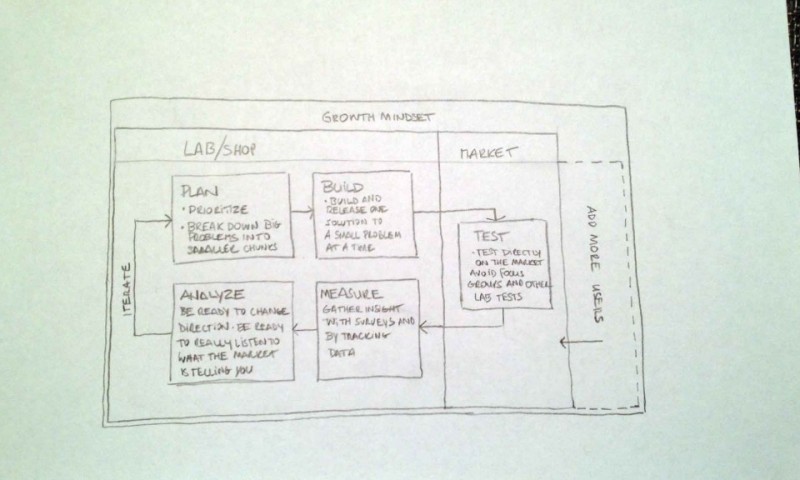
Iteration leads to innovation
Going from prototype to v.1.0 and beyond
Iteration. Innovation. Disruption. The next big thing. The importance of being innovative isn’t new. Ask any experienced leader. In today’s world of differentiate-or-die, there’s little market share left to me too products. Another important thing is speed. Without speed, teams can be consumed in slowly developing products that by the time they’re ready, they’re obsolete. Leaders need to direct their teams to create something new and valuable, and to do it fast. Here are a few tips that will provide speed on the way to the next big thing:
1. Win quickly, win often. Karl Weick defines “small wins” as “a series of concrete, complete outcomes of moderate importance build a pattern that attracts allies and deters opponents.” In his book Little Bets, Peter Sims advices seeking to have small wins throughout your iterative development process. These small wins will help you keep managers and investors interested and confident. Not only that. Small wins counteract the sometimes inevitable frustration of failure, which is part of any creative endeavour.
2. Mistakes are cool. In searching for something truly new, teams will have to experiment in uncharted territories. Doing this will mean trying things that will fail. Teams need to be okay with failure. They need to see it as part of the journey. Leaders should welcome mistakes but be alert to prevent their teams from making the same mistakes twice. Leaders should also make sure their teams arrive to failure quickly so they can learn without breaking the bank.
3. Keep a growth mindset. Having a growth mindset means having an attitude towards difficulties that one may face while trying to achieve his or her goals. A growth mindset is the antithesis of a fixed mindset. Here’s a simple chart that provides a quick reference of the kind of reactions that each mind-set provides in the face of events.
|
Growth Mindset |
Fixed Mindset |
|
|
Challenges |
Embraces |
Avoids |
|
Obstacles |
Persists |
Gives up |
|
Effort |
Sees it as path to mastery |
Sees it as fruitless |
|
Criticism |
Learns from it |
Ignores it |
|
Success of others |
Finds inspiration |
Feels threatened |
For a complete understanding of the growth mindsets and how it can be developed in yourself and others, read Carol Dweck’s Mindset: The New Psychology of Success.
4. Grow the user base. Now that you have a product, start growing the user base. Community management is important to keep the product being shaped with the right usage. A community manager that likes the product and has a large network can be a surprisingly powerful hire (or partner) in this stage of product development.
5. Release quickly. Speed is important. There are a lot of things you need to learn from the market so it’s important that you learn these things quickly. One way to gain speed is by breaking down big problems into smaller subproblems. Develop a solution to a small problem and launch it. See how the market reacts and use that information to prioritize your next release.
6. Test on the market directly. Avoid at all costs to develop features, or even worse, optimize features, before you have evidence that the market will care about them. This is why you want to release quickly, measure and ask for feedback, and stay emotionally detached from specific features so you can nix them without drama.
7. Measure and ask for feedback. Testing right on the market gives you real time information on how the real world reacts to features as well as to your product overall. When tracking important usage data points, Google Analytics isn’t enough. While Google Analytics can tell you if people are engaging with your product, it cannot tell you how exactly. You will need to think up the important questions and add ways to get your product to give you the answers. Some metrics may include number of account registrations, the last time users were seen using the product, whether users are using a specific feature, etc.
8. Stay cool. Releasing quickly will also help you avoid the trap of getting emotionally attached to ideas or features. Test your ideas with your users before you invest time and money to the point where you must continue because of the investment. Entrepreneurs, particularly founders, too often fall into this trap. They continue betting on failed products for years in spite of evidence showing that the market simply doesn’t care.
9. Be ready to change direction. Another benefit of staying cool and learning from the market quickly is that you will be more attuned to signals that suggest a change in direction is needed. Known as pivoting, changing direction means applying your product (or part of it) to a different industry, or adjusting the mission statement in response to how the market is using your product.
10. User experience and user interface are important. Some product developers fall in the trap of thinking that an incomplete user experience (UX) and a rough user interface (UI) suffice and can be improved over time. Part of this is true: it’s okay to be somewhat imperfect as you iterate. However, it is important to understand that this phase is different from the prototype phase. In the prototype phase, an incomplete UX and clunky UIs may be okay because the point is to validate the idea. In the product development phase, the market will hold you to the expectations set by other products, even when these other products don’t compete with yours. Delivering below expectation is enough to turn users away. And this is unfair your product.
